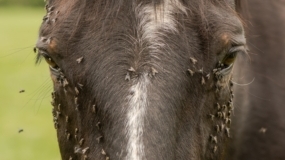|
H.J. Equine, Inc. Blog
Will CBD Oil help with my horses skin condition?
Thursday, April 7, 2022
By Jeri Lockwood
The skin is the largest organ in the body. The skin is a thin layer of tissue forming the natural outer covering of the body of a person or animal.
Many skin conditions are due to inflammation, and the anti-inflammatory properties of CBD Oil is a natural way to treat Rainrot, Ringworm, Mange, Warts, Rashes, Dandruff, Bug Bites, etc.
There are eight common equine skin diseases:
- Rainrot is a bacterial infection. The causative organism, Dermatophilus congolensis, can reside on the skin without causing trouble, but it multiplies rapidly in a moist environment. If the bacteria find a break in the skin, whether a small wound or insect bite, an active infection can develop. Anything that compromises a horse's immunity—advanced age, malnutrition, illness—can make him more susceptible to the infection, as can having a heavy winter coat, which tends to trap moisture against the skin.
- Ringworm (fungal dermatitis) Which is rounded hairless patches with crusty, scabby skin. The lesions are most common on the face, neck, shoulders, chest or under the saddle or girth, but they can appear anywhere on the body. The affected areas may be sore or itchy, but they often cause no discomfort, and the horse may appear otherwise healthy.
- Warts (papillmoas) Which are raised gray or pink cauliflower-like growths that are usually fairly small, not much bigger than peas. They may appear singly or in clusters, most commonly on the muzzle or around the eyes but also occasionally on the ears, genitals and lower legs. The growths do not appear to cause any pain or discomfort.
- Aural Plaques (papillary acanthoma, eart papillomas) Which are flat, crusty, raised white lesions inside the ears; underneath, the skin may be pink and sensitive. Aural plaques usually cause no pain and are considered to be just a cosmetic problem. But biting flies may irritate the lesions, and some horses may begin to resist bridling or having their ears handled. Both ears are likely to be affected. They are not likely to shrink or go away on their own.
- Primary Seborrhea (dandruff) - Seborrhea can be dry or oily. In the dry form, small flakes of skin appear routinely, usually at the base of the mane and tail, and sand-like flecks may appear on the girth area or anywhere sweat accumulates. Oily seborrhea causes large, waxy crusts, often on the elbows, hocks or lower legs; when peeled off, these may leave hairless patches up to several inches in diameter. Dandruff sometimes causes a fetid odor, but the horse is not usually itchy or in pain.
- Eosinophilic Granuloma with Collegen Degeneration (nodular collagenolytic granuloma, nodular necrobiosis, or simply nodules) These are distinct, firm nodules about the size of a dime or smaller, found usually in the neck, back and withers. Several small nodules may cluster together to form what appears to be a larger lump. The skin above is normal, with no hair loss, and the nodules do not contain pus. The bumps can occur in horses of any age, breed or gender. They usually are not painful or itchy, unless they've been irritated by rubbing. Over time, they may mineralize, which makes them feel harder.
- Mange are small, round bumps at first, soon followed by bald spots, with scaly, thickened skin, usually on the lower legs of draft horses with heavy feathering, although any horse can be affected. In more serious cases the skin may be rubbed raw and show signs of secondary infections. Mange causes itching, and horses will rub, stamp and bite at their legs. In rare cases, mange may appear on other parts of the body.
- Lice (pediculosis) Which appears as hair loss from rubbing, usually appearing first on the shoulders and neck, as well as on the head and the base of the mane and tail. Affected areas are intensely itchy and may also have abrasions and scabs from rubbing and possibly secondary infections. Flattened insects up to two to four millimeters long may be visible if the hair is parted and the skin examined in good light. Pale, translucent eggs may be attached to nearby hairs. The horse is also likely to be generally unthrifty and in poor health. Lice infestations tend to be more severe during the winter months but can occur at any time of year.
Colorado State University did a great study on CBD and Equine's skin sensitivity. for more information on this study please click on this link https://www.hjequine.com/blog/?42685/will-cbd-oil-help-my-horse-with-pain-sensitivity
|
|
|
|
|




